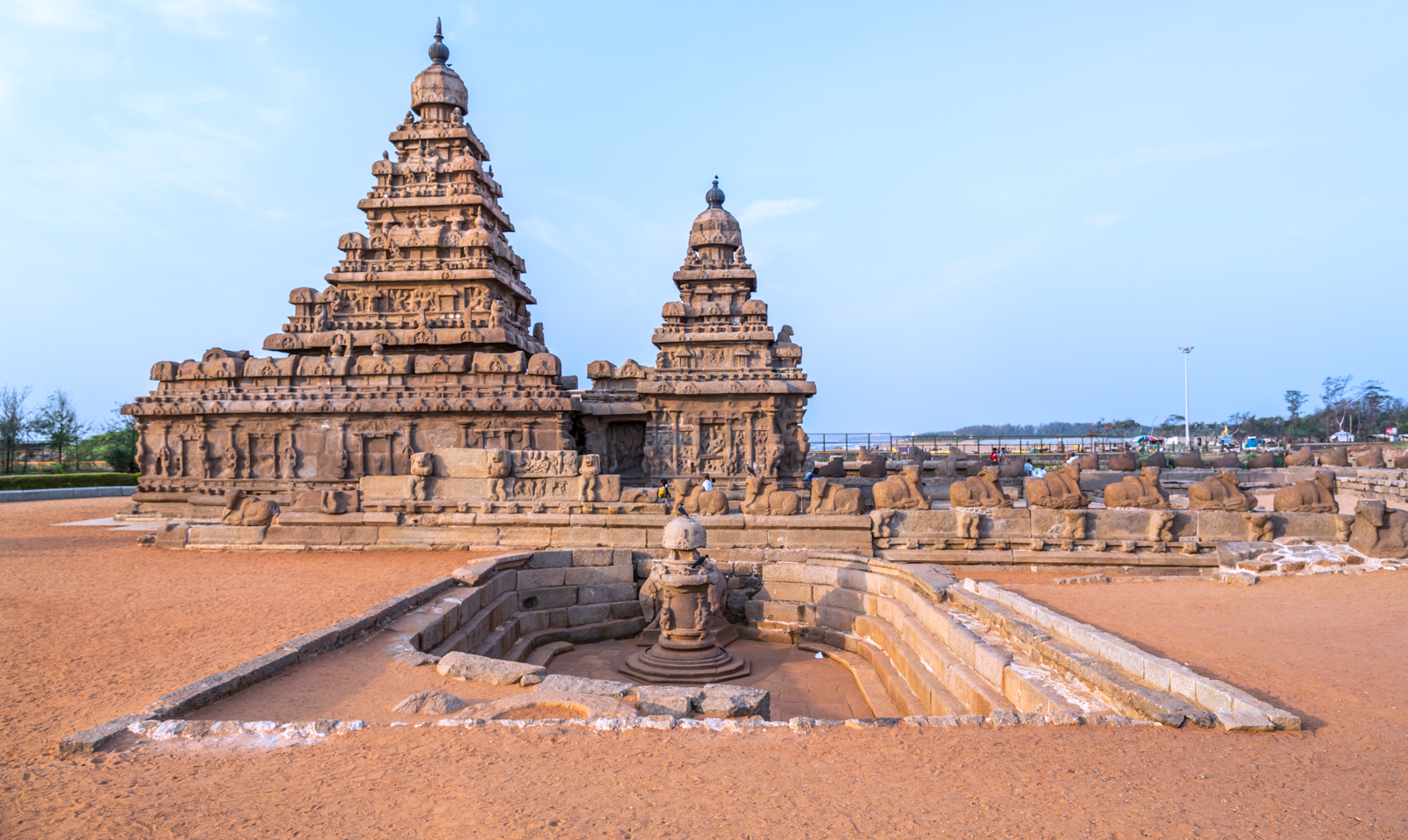Mahabalipuram, a UNESCO World Heritage Site located along the southeastern coast of India, is a treasure trove of ancient history, art, and culture. Known for its stunning rock-cut temples and awe-inspiring monuments, this historic town is a testimony to the glorious past of the Pallava dynasty.
With its beautiful coastal backdrop, intricate sculptures, and majestic monuments, Mahabalipuram holds a special place in the hearts of travelers, history enthusiasts, and art lovers alike.
The town’s fascinating architectural wonders reflect the genius of ancient Indian craftsmanship and the rich cultural heritage that continues to attract visitors from all over the world.
Historical Significance of Mahabalipuram
Mahabalipuram, also known as Mamallapuram, derives its name from the ancient Pallava King Narasimhavarman I, also called Mamalla, which means “great wrestler” in Tamil.
This coastal town served as the capital of the Pallava dynasty during the 7th and 8th centuries and was a bustling center of trade, culture, and religion. Under the Pallavas, Mahabalipuram flourished as a key port city and an important center for the arts and architecture.
The Pallava dynasty’s patronage of art and architecture led to the creation of many monuments, temples, and sculptures in the region. These architectural marvels are designed in a unique style that blends Dravidian architecture with influences from early Buddhist architecture.
Read : Avartana of Chennai Declared as No. 1 Restaurant in India, 2nd in Asia
The most notable among these are the rock-cut temples and the Shore Temple, which stand as enduring symbols of the Pallava’s cultural and artistic achievements.
Mahabalipuram’s prominence grew even more during the reign of Narasimhavarman II (Rajasimha) in the 8th century. Under his leadership, Mahabalipuram became a key cultural hub, attracting scholars, artists, and merchants from across India and abroad.
Read : Temples and Tranquility: Must-Visit Places in Tamil Nadu
The town also served as a thriving port for maritime trade with Southeast Asia, including Sri Lanka, Thailand, and Malaysia. This historical significance has ensured Mahabalipuram’s place in Indian history, and its monuments continue to showcase the rich legacy of the Pallava dynasty.
Architectural Wonders of Mahabalipuram
Mahabalipuram is renowned for its exceptional collection of ancient temples, rock-cut caves, monolithic structures, and intricately carved sculptures. The town’s monuments are primarily made from granite, and many of them are still in excellent condition, attracting millions of tourists every year. The key architectural highlights of Mahabalipuram include:
The Shore Temple
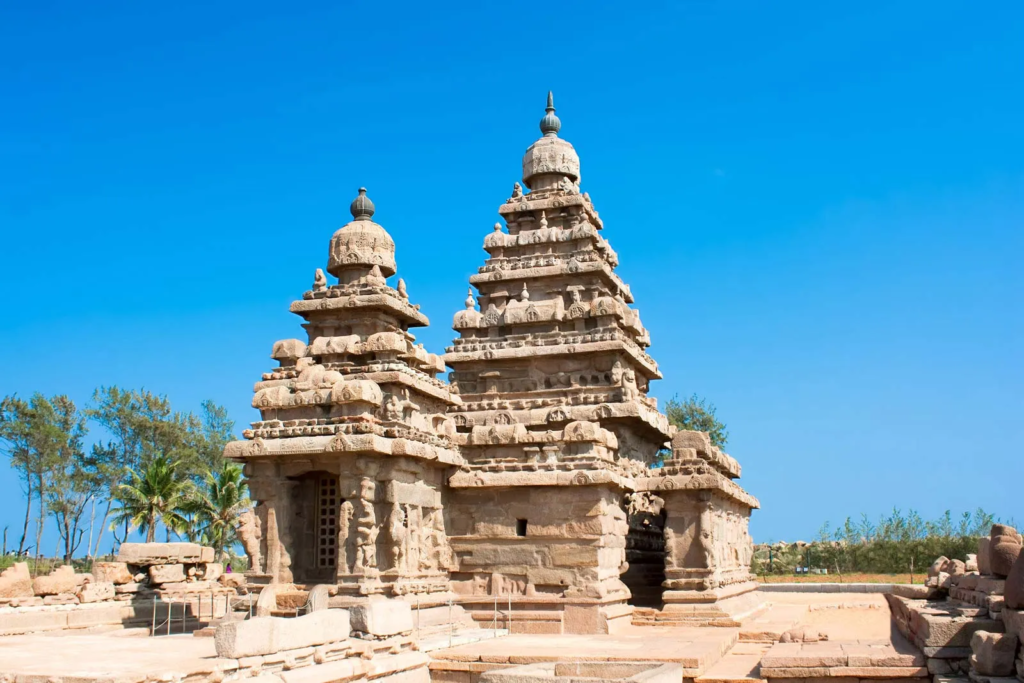
One of the most iconic structures in Mahabalipuram, the Shore Temple is a stunning example of early Dravidian temple architecture. Built during the reign of Narasimhavarman II, the Shore Temple stands on the edge of the Bay of Bengal, offering spectacular views of the ocean.
This temple complex consists of two shrines—one dedicated to Lord Shiva and the other to Lord Vishnu. Its remarkable sculptures and intricate carvings are a testament to the expertise of the Pallava artisans.
The Shore Temple is particularly known for its graceful design, with towering spires and stone carvings of deities, animals, and mythological creatures. The temple is an outstanding example of the Pallava style of temple architecture, which greatly influenced the development of South Indian temple architecture in the centuries that followed.
Pancha Rathas (Five Chariots)
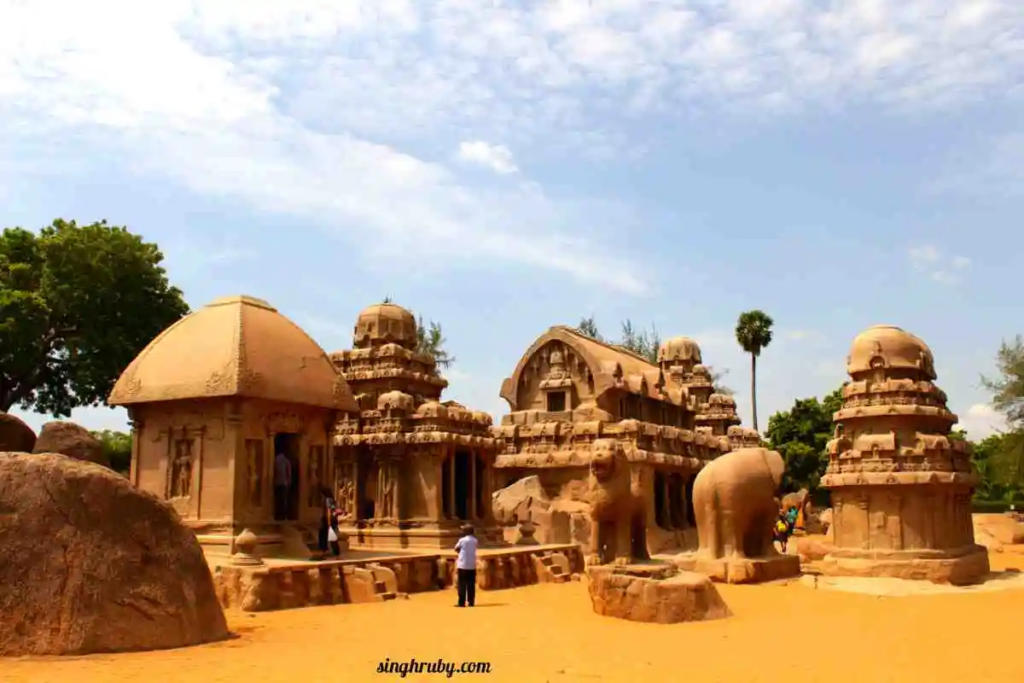
The Pancha Rathas are a group of five monolithic temples, each carved out of a single block of stone. These temples are named after the Pandavas, the heroes of the Indian epic Mahabharata, with each ratha (chariot) representing one of the Pandava brothers.
The Pancha Rathas are impressive examples of rock-cut architecture, with intricately carved pillars, sculptures, and facades. While the temples are not all completed, their sheer scale and artistry are breathtaking.
The structures are uniquely shaped like chariots and stand as solitary monolithic blocks. Each ratha has its distinct architectural style, with some resembling the shapes of Buddhist stupas and others reflecting traditional Hindu temple designs. Among these, the Dharmaraja Ratha, dedicated to Yudhishthira, is the most prominent, with a large, elaborately carved dome-like structure.
Arjuna’s Penance (Descent of the Ganges)
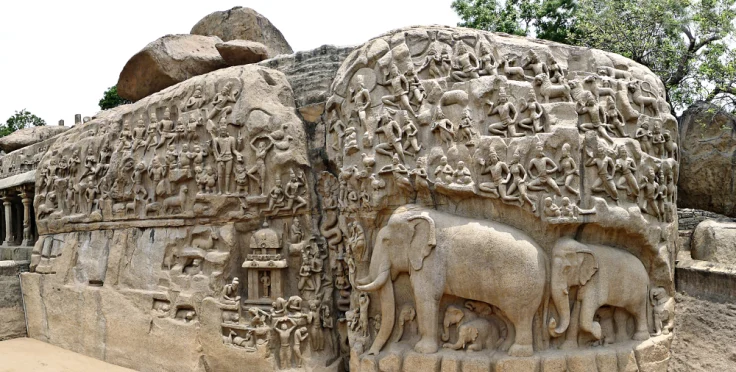
One of the most famous monuments in Mahabalipuram, Arjuna’s Penance, is a massive bas-relief that tells the story of the descent of the river Ganges to the earth. The relief, carved into the side of a large rock, measures about 43 feet (13 meters) in length and 30 feet (9 meters) in height.
The sculpture depicts a variety of gods, animals, and mythological figures, with the central figure being Arjuna, the hero of the Mahabharata.
This artwork is considered one of the finest examples of Indian rock art. The relief is symbolic of the cultural richness of ancient India and depicts the legend of Arjuna performing intense penance to receive the boon of the Ganges from Lord Shiva. The detailed carvings and the stunning scale of this monument make it a must-visit site for history lovers and art enthusiasts.
Mahabalipuram’s Cultural Heritage and Traditions
Beyond its architectural marvels, Mahabalipuram is also known for its vibrant cultural heritage and deep-rooted traditions. The town has long been a center of art, dance, and sculpture. The Pallava kings were great patrons of the arts, and Mahabalipuram became a hub for artisans, sculptors, and scholars.
Traditional Dance and Festivals
Mahabalipuram is famous for its traditional dance performances, particularly Bharatanatyam, which is one of the oldest classical dance forms in India. The annual Mahabalipuram Dance Festival, held in December and January, is a major cultural event that attracts dancers and tourists from across the world.
During this festival, the temples of Mahabalipuram become the backdrop for mesmerizing dance performances, with artists performing in front of the Shore Temple and other monuments.
The town also celebrates other regional festivals with much fanfare, such as Pongal, the Tamil harvest festival, and the Navaratri festival. These festivals feature colorful processions, traditional music, dance, and local rituals, allowing visitors to experience the local culture and traditions.
Sculpture and Arts
Mahabalipuram has a long history of sculpture making, with many of its ancient monuments displaying exceptional craftsmanship. The art of stone sculpture was highly refined during the Pallava period, and it continues to thrive in the region today. Local artisans, known as “stone carvers,” have kept the tradition alive, creating beautiful sculptures for temples, homes, and collectors.

Visitors can see artisans at work in the local workshops, where they carve intricate stone figures, including replicas of the monuments in Mahabalipuram. Many tourists visit these workshops to purchase handmade souvenirs, from small sculptures to large stone carvings.
Tourist Experience in Mahabalipuram
Mahabalipuram is a perfect blend of history, culture, and natural beauty. Apart from visiting the monuments, tourists can explore the town’s lovely beaches, enjoy water sports, and experience the local cuisine, which includes fresh seafood, traditional South Indian dishes, and spicy Tamil delicacies.
Beaches of Mahabalipuram
Mahabalipuram’s coastline is dotted with serene beaches, making it an ideal destination for those looking to relax by the sea. The town’s main beach is located near the Shore Temple, offering a picturesque view of the ocean and the temple complex. The quiet, clean beaches are perfect for leisurely walks, beach photography, and peaceful sunset views.
For adventure enthusiasts, the beaches also offer opportunities for water sports like surfing, kayaking, and parasailing. The calm waters of the Bay of Bengal make it an excellent place for both beginners and experienced water sports lovers.
Shopping and Local Cuisine
Mahabalipuram is home to several markets and shops where tourists can purchase traditional handicrafts, including stone sculptures, jewelry, and souvenirs. The markets are filled with vibrant colors and bustling with local artisans selling their goods. Visitors can find everything from miniature replicas of the famous monuments to handwoven textiles and traditional Tamil handicrafts.
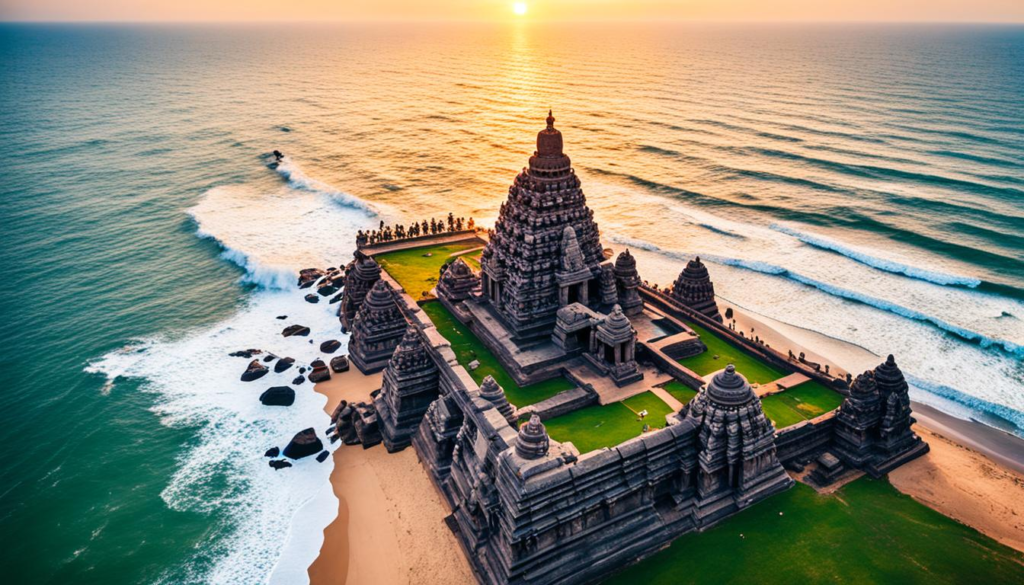
The town also offers a variety of dining options, ranging from simple roadside eateries to upscale restaurants. Seafood lovers can enjoy fresh fish and prawns, while South Indian delicacies like dosas, idlis, and vadas are available at almost every restaurant. The food is often seasoned with aromatic spices and served with chutneys and sambar, making for an authentic South Indian culinary experience.
Mahabalipuram, with its timeless monuments, rich history, and vibrant cultural heritage, is a must-visit destination for anyone interested in ancient architecture, history, and the arts. From the rock-cut temples and the Shore Temple to the exquisite sculptures and the lively festivals, Mahabalipuram offers a unique blend of the old and the new.
Its picturesque beaches and local traditions add to the charm, making it a perfect getaway for travelers seeking both relaxation and an immersion in India’s cultural wealth.
Whether you are an art lover, a history enthusiast, or simply looking for a peaceful retreat by the sea, Mahabalipuram is sure to leave you awe-struck and inspired by its ancient beauty and charm.
let’s enjoy few years on earth with peace and happiness….✍🏼🙏

